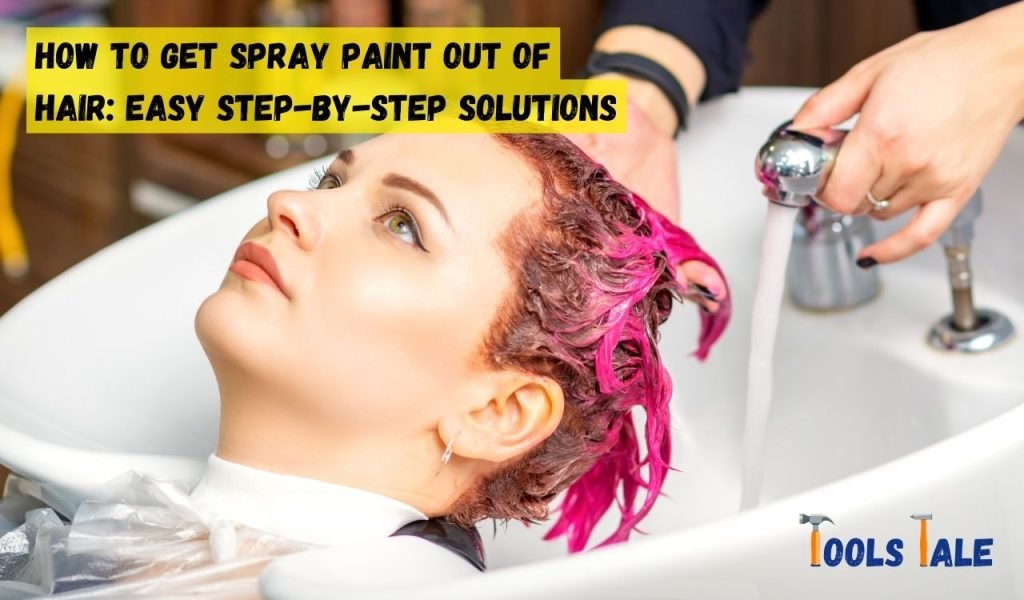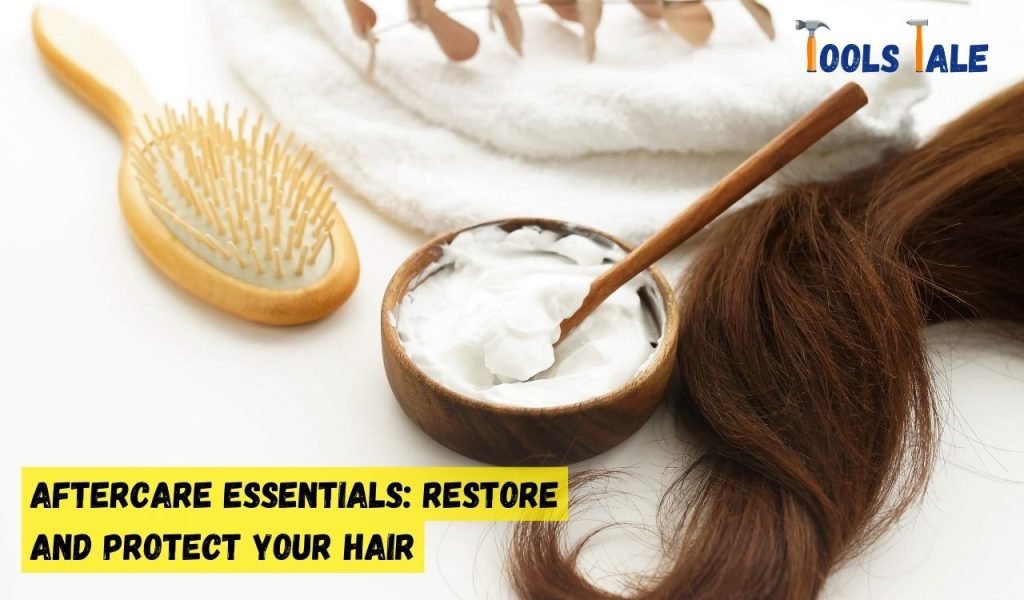Physical Address
304 North Cardinal St.
Dorchester Center, MA 02124
Physical Address
304 North Cardinal St.
Dorchester Center, MA 02124

Ever found yourself in a colorful conundrum with spray paint in your hair? Don’t fret; we’re here to unravel the solution! Discovering how to get spray paint out of hair can be a game-changer. Whether it was an artistic adventure gone wrong or a crafty incident, fear not – we’ve got the hacks to rescue your strands.
Bid farewell to those paint-stained worries and welcome back your natural hair. In this brief guide, we’ll unveil the secrets to a paint-free, radiant mane. Let’s jump in and bring your hair back to life!
Key Summary: How to Get Spray Paint Out of Hair?
Accidentally got spray paint in your hair? Don’t worry! To remove spray paint from hair, start by applying a generous amount of cooking oil or mayonnaise to the affected area. Let it sit for 15-20 minutes, then gently comb out the paint using a fine-toothed comb. Wash your hair thoroughly with shampoo and conditioner.
Spray paint, known for its versatility and convenience in the realm of art and DIY projects, can inadvertently find its way into your hair, presenting a unique challenge. To effectively remove spray paint from hair, understanding the different types of spray paint goods and the potential damage they can cause is crucial.
Spray paints come in various formulations tailored for specific surfaces, and these formulations can impact how they interact with human hair. The two primary types are oil-based and water-based spray paints.
Oil-based spray paints are solvent-based and contain organic compounds. These paints are highly durable and offer a glossy finish. However, they are challenging to remove from hair due to their adhesive properties. The solvents can penetrate the hair cuticle, making the paint stubborn and resistant to simple washes.
When spray paint of this type comes into contact with hair, it can cause the strands to clump together, leading to knots and tangles. Additionally, the paint’s chemicals can strip the hair of its natural oils, leaving it dry and brittle.
Water-based spray paints, on the other hand, use water as a carrier for the paint pigments. They are less harmful to both surfaces and hair compared to oil-based counterparts. Water-based paints are easier to clean and remove, making the task of eliminating them from hair less arduous.
However, even though these paints are water-based, they may still pose challenges in hair removal. The pigments can stick to the hair shaft and become entangled, necessitating a thorough removal process to avoid damage.
Spray paint, regardless of type, can cause hair damage if not addressed promptly and correctly. Pulling or tugging at the hair during removal attempts can lead to breakage and further entrench the paint in the strands.
To mitigate damage, it’s important to refrain from rubbing or vigorously washing the affected area. Instead, opting for a gentle removal method and using appropriate solvents or conditioners can aid in the paint’s dissolution without harming the hair.
Understanding the properties of different spray paint types is essential in managing incidents where spray paint ends up in your hair. Choosing appropriate removal techniques based on the type of paint can minimize damage and contribute to a successful paint removal process while maintaining the health of your hair.
Accidents happen, and getting spray paint in your hair is an unfortunate mishap that can occur during art projects or DIY ventures. Understanding the potential consequences of having spray paint in your hair is essential for taking the right steps to mitigate any damage promptly.
When spray paint comes into contact with your hair, it can cause the strands to clump together. The paint adheres to the hair fibers, creating knots and tangles. This makes the hair challenging to comb or style.
The chemicals present in spray paint, especially oil-based variants, can strip the natural oils from your hair. This leads to dryness and brittleness, making the hair more prone to breakage.
Spray paint contains pigments and dyes that can stain the hair. The intensity of the staining varies based on the paint type and the hair’s porosity. Removing these stains can be a difficult task.
The chemicals in spray paint can irritate the scalp, causing redness, itching, or discomfort. This is more likely if you have a sensitive scalp or if the paint is left on the hair for an extended period.
Depending on the type of spray paint, it can be challenging to remove from hair. Oil-based spray paints are particularly stubborn and require thorough and careful removal methods to avoid further entangling and damaging the hair.
Getting spray paint in your hair can be concerning, but knowing how to handle the situation is key. By understanding the potential effects and taking immediate and appropriate steps for removal, you can minimize damage and preserve the health and appearance of your hair. If you’re uncertain about the best removal approach, seeking guidance from a professional hairdresser is advisable.

Finding spray paint in your hair can be a stressful situation, but fear not -there are effective methods to remove spray paint without causing damage to your hair. Here’s a comprehensive, step-by-step guide to help you navigate this unexpected and challenging situation.
The first and most crucial step in dealing with spray paint in your hair is to act swiftly. The longer the paint sits in your hair, the more difficult it will be to remove. As soon as you notice the spray paint in your hair, begin the removal process.
Before you start the removal process, gather the necessary supplies:
Begin by applying a generous amount of hair conditioner or oil to the areas of your hair where the spray paint is present. Ensure that the paint is thoroughly saturated with the conditioner or oil.
Using a wide-toothed comb, carefully and gently detangle your hair, starting from the tips and working your way up to the roots. The conditioner or oil will help in the detangling process.
Allow the conditioner or oil to saturate the paint for at least 10 to 15 minutes. This will give the conditioner or oil sufficient time to soften the paint, making it easier to remove.
After allowing the conditioner or oil to saturate, start gently wiping away the paint using a soft cloth or cotton balls. Be patient and gentle to avoid hair breakage. The softened paint should start to come off relatively easily.
Once you’ve removed a significant amount of paint, rinse your hair thoroughly with warm water. Assess the progress and check if there’s more paint to be removed. If needed, repeat the process until the paint is fully eliminated.
After successfully removing the paint, wash your hair with a gentle shampoo to ensure that all the paint residue is gone. Follow up with a deep conditioning treatment to restore moisture to your hair and keep it healthy.
If the spray paint is persistent and proves difficult to remove or if you’re unsure about the removal process, consider seeking help from a professional hairstylist. They have the expertise to handle such situations and can provide the best advice and assistance.
Dealing with spray paint in your hair can be stressful, but with the right approach and immediate action, you can effectively remove the paint without causing harm to your hair.
These step-by-step solutions will guide you through the process and help you restore your hair to its natural, healthy state. Remember, patience and gentle handling are essential throughout the removal process to protect your hair and maintain its health and beauty.
Accidentally getting spray paint in your hair can be concerning, but there are effective methods to remove it without causing damage. Here are the nine best methods for removing spray paint from your hair:
Choose the method that best suits your situation based on the type of paint and your hair’s condition. Always handle your hair gently during the removal process to prevent any damage.

After successfully removing spray paint from your hair, it’s vital to focus on aftercare to restore its health and protect it from further damage. Here are the essential steps for aftercare:
Aftercare is crucial to ensure your hair regains its natural shine, strength, and moisture levels. By following these aftercare essentials, you’ll promote hair health and protect it from potential damage in the future.
Preventing spray paint mishaps in your hair involves proactive measures and thoughtful precautions. Here are effective prevention tips to keep your hair paint-free:
By implementing these prevention tips and adopting a proactive approach, you can effectively protect your hair from spray paint and other potential hazards, ensuring it stays paint-free in the future.
Inadvertently finding spray paint in your hair can be daunting, but with swift and gentle action, you can successfully remove it. Choose a suitable method based on the paint type, prioritize gentle handling, and follow up with essential aftercare to restore your hair’s health.
Remember, prevention is key—take precautions to keep your hair paint-free in future projects. Stay informed, act promptly, and embrace these measures to ensure your locks remain vibrant and free from unwanted hues.
Spray paint is not designed for use on hair, making it less likely to be permanent. It can be effectively removed if dealt with promptly using appropriate methods. The key is swift action to prevent the paint from drying and adhering firmly to the hair shaft.
For a natural approach, use oils like olive or coconut oil to soften the paint. Apply the oil generously, allowing it to penetrate the painted areas and loosen the paint. Follow up with gentle combing to remove the softened paint. Rinse and repeat if necessary.
Before removal, consider the type of spray paint. Water-based paint is generally easier to remove than oil-based paint. Assess your hair’s health to choose a suitable method that won’t cause further damage. The amount and intensity of the paint will also influence the removal process.
Using a hairdryer to remove spray paint is not recommended. The heat can cause the paint to set or harden, making it more difficult to remove. Additionally, the high temperature can damage the hair, leaving it brittle and prone to breakage.
At home, start by applying a generous amount of conditioner or oil to the painted areas. Allow it to sit and soften the paint. Gently comb through the hair to remove the paint. Rinse and repeat as needed until the paint is completely removed, then follow up with a gentle shampoo.
After removing spray paint, deep condition your hair to restore moisture. Avoid heat styling and opt for protective hairstyles to prevent further damage. Regular trims will promote healthy hair growth.
The duration to remove spray paint from hair varies based on the paint type, the amount of paint, and the chosen removal method. It may take anywhere from 30 minutes to a few hours for complete removal.